Indirect Calorimetry Performance Using a Handheld Device Compared to the Metabolic Cart in Outpatients with Cirrhosis
Abstract
1. Introduction
2. Materials and Methods
2.1. Patients
2.2. Procedure
2.3. Statistical Analysis
3. Results
4. Discussion
4.1. Strengths and Limitations
4.2. Future Direction
5. Conclusions
Author Contributions
Conflicts of Interest
References
- Cheung, K.; Lee, S.S.; Raman, M. Prevalence and Mechanisms of Malnutrition in Patients with Advanced Liver Disease, and Nutrition Management Strategies. Clin. Gastroenterol. Hepatol. 2011. [Google Scholar] [CrossRef]
- Bugianesi, E.; Kalhan, S.; Burkett, E.; Marchesini, G.; McCullough, A. Quantification of gluconeogenesis in cirrhosis: Response to glucagon. Gastroenterology 1998, 115, 1530–1540. [Google Scholar] [CrossRef]
- Chang, W.K.; Chao, Y.C.; Tang, H.S.; Lang, H.F.; Hsu, C.T. Effects of Extra-Carbohydrate Supplementation in the Late Evening on Energy Expenditure and Substrate Oxidation in Patients with Liver Cirrhosis. J. Parenter. Enter. Nutr. 1997, 21, 96–99. [Google Scholar] [CrossRef]
- Maharshi, S.; Sharma, B.C.; Srivastava, S. Malnutrition in cirrhosis increases morbidity and mortality. J. Gastroenterol. Hepatol. 2015, 30, 1507–1513. [Google Scholar] [CrossRef]
- Norman, K.; Kirchner, H.; Lochs, H.; Pirlich, M. Malnutrition affects quality of life in gastroenterology patients. World J. Gastroenterol. 2006, 12, 3380–3385. [Google Scholar] [CrossRef]
- Englesbe, M.J.; Patel, S.P.; He, K.; Lynch, R.J.; Schaubel, D.E.; Harbaugh, C.; Holcombe, S.A.; Wang, S.C.; Segev, D.L.; Sonnenday, C.J. Sarcopenia and Mortality after Liver Transplantation. J. Am. College Surg. 2010, 211, 271–278. [Google Scholar] [CrossRef]
- Huisman, J.E.; Trip, J.E.; Siersema, D.P.; Van Hoek, J.B.; Van Erpecum, J.K. Protein energy malnutrition predicts complications in liver cirrhosis. Eur. J. Gastroenterol. Hepatol. 2011, 23, 982–989. [Google Scholar] [CrossRef]
- Caly, W.; Strauss, E.; Carrilho, F.; Laudanna, A.A. Different degrees of malnutrition and immunological alterations according to the aetiology of cirrhosis: A prospective and sequential study. Nutr. J. 2003, 2. [Google Scholar] [CrossRef]
- Bémeur, C.; Butterworth, R.F. Nutrition in the Management of Cirrhosis and its Neurological Complications. J. Clin. Exp. Hepatol. 2014, 4, 141–150. [Google Scholar] [CrossRef]
- Henkel, A.; Buchman, A. Nutritional support in patients with chronic liver disease. Nat. Clin. Pract. Gastroenterol. Hepatol. 2006, 3, 202–209. [Google Scholar] [CrossRef]
- Iwasa, M.; Iwata, K.; Hara, N.; Hattori, A.; Ishidome, M.; Sekoguchi-Fujikawa, N.; Mifuji-Moroka, R.; Sugimoto, R.; Fujita, N.; Kobayashi, Y.; et al. Nutrition therapy using a multidisciplinary team improves survival rates in patients with liver cirrhosis. Nutrition 2013, 29, 1418–1421. [Google Scholar] [CrossRef]
- Plauth, M.; Cabré, E.; Riggio, O.; Assis-Camilo, M.; Pirlich, M.; Kondrup, J.; Ferenci, P.; Holm, E.; Vom Dahl, S.; Müller, M.J.; et al. ESPEN Guidelines on Enteral Nutrition: Liver disease. Clin. Nutr. 2006, 25, 285–294. [Google Scholar] [CrossRef]
- Mahan, L.K. Krause’s Food, Nutrition & Diet Therapy, 8th ed.; Saunders: Philadelphia, PA, USA, 1992. [Google Scholar]
- Müller, M.J.; Böttcher, J.; Selberg, O.; Weselmann, S.; Böker, K.H.; Schwarze, M.; von zur Mühlen, A.; Manns, M.P. Hypermetabolism in clinically stable patients with liver cirrhosis. Am. J. Clin. Nutr. 1999, 69, 1194–1201. [Google Scholar] [CrossRef]
- Glass, C.; Hipskind, P.; Cole, D.; Lopez, R.; Dasarathy, S. Handheld calorimeter is a valid instrument to quantify resting energy expenditure in hospitalized cirrhotic patients: A prospective study. Nutr. Clin. Pract. 2012, 27, 677–688. [Google Scholar] [CrossRef]
- Merli, M.; Berzigotti, A. EASL Clinical Practice Guidelines on nutrition in chronic liver disease. J. Hepatol. 2019, 70, 172–193. [Google Scholar] [CrossRef]
- Haugen, H.A.; Chan, L.-N.; Li, F. Indirect calorimetry: A practical guide for clinicians. Nutr. Clin. Pract. 2007, 22, 377–388. [Google Scholar] [CrossRef]
- da Rocha, E.E.M.; Alves, V.G.F.; da Fonseca, R.B.V. Indirect calorimetry: Methodology, instruments and clinical application. Curr. Opinion Clin. Nutr. Metab. Care 2006, 9, 247–256. [Google Scholar] [CrossRef]
- Cooper, J.A.; Watras, A.C.; O’Brien, M.J.; Luke, A.; Dobratz, J.R.; Earthman, C.P.; Schoeller, D.A. Assessing validity and reliability of resting metabolic rate in six gas analysis systems. (Author abstract). J. Am. Diet. Assoc. 2009, 109, 128. [Google Scholar] [CrossRef]
- Fullmer, S.; Benson-Davies, S.; Earthman, C.P.; Frankenfield, D.C.; Gradwell, E.; Lee, P.S.P.; Piemonte, T.; Trabulsi, J. Evidence analysis library review of best practices for performing indirect calorimetry in healthy and non-critically ill individuals. J. Acad. Nutr. Diet. 2015, 115, 1417–1446. [Google Scholar] [CrossRef]
- Frankenfield, D.C.; Ashcraft, C.M.; Wood, C.; Chinchilli, V.M. Validation of an indirect calorimeter using n-of-1 methodology. Clin. Nutr. 2016, 35, 163–168. [Google Scholar] [CrossRef]
- Schadewaldt, P.; Nowotny, B.; Strassburger, K.; Kotzka, J.; Roden, M. Indirect calorimetry in humans: A postcalorimetric evaluation procedure for correction of metabolic monitor variability. Am. J. Clin. Nutr. 2013, 97, 763–773. [Google Scholar] [CrossRef] [PubMed]
- Wines, K.N.; Rzepecki, A.K.; Andrews, A.L.; Dechert, R.E. Validation of the V(max) metabolic cart in a simulated pediatric model. JPEN J. Parenter. Enter. Nutr. 2015, 39, 353–358. [Google Scholar] [CrossRef]
- Campillo, B.; Richardet, J.P.; Scherman, E.; Bories, P.N. Evaluation of nutritional practice in hospitalized cirrhotic patients: Results of a prospective study. Nutrition 2003, 19, 515–521. [Google Scholar] [CrossRef]
- Hipskind, P.; Glass, C.; Charlton, D.; Nowak, D.; Dasarathy, S. Do handheld calorimeters have a role in assessment of nutrition needs in hospitalized patients? A systematic review of literature. Nutr. Clin. Pract. 2011, 26, 426–433. [Google Scholar] [CrossRef]
- McDoniel, S.O. Systematic review on use of a handheld indirect calorimeter to assess energy needs in adults and children. Int. J. Sport Nutr. Exerc. Metab. 2007, 17, 491–500. [Google Scholar] [CrossRef]
- Reeves, M.M.; Capra, S.; Bauer, J.; Davies, P.S.W.; Battistutta, D. Clinical accuracy of the MedGem indirect calorimeter for measuring resting energy expenditure in cancer patients. Eur. J. Clin. Nutr. 2005, 59, 603–610. [Google Scholar] [CrossRef]
- Hlynsky, J.; Birmingham, C.L.; Johnston, M.; Gritzner, S. The agreement between the MedGem indirect calorimeter and a standard indirect calorimeter in anorexia nervosa. Eat. Weight Disord. EWD 2005, 10, e83–e87. [Google Scholar] [CrossRef] [PubMed]
- Detsky, A.; McLaughlin Baker, J.; Johnston, N.; Whittaker, S.; Mendelson, R.; Jeejeebhoy, K. What is subjective global assessment of nutritional status? JPEN J. Parenter Enter. Nutr. 1987, 11, 8–13. [Google Scholar] [CrossRef]
- McClave, S.A.; Spain, D.A.; Skolnick, J.L.; Lowen, C.C.; Kieber, M.J.; Wickerham, P.S.; Vogt, J.R.; Looney, S.W. Achievement of steady state optimizes results when performing indirect calorimetry. JPEN J. Parenter. Enter. Nutr. 2003, 27, 16–20. [Google Scholar] [CrossRef]
- Compher, C.; Hise, M.; Sternberg, A.; Kinosian, B.P. Comparison between Medgem and Deltatrac resting metabolic rate measurements. Eur. J. Clin. Nutr. 2005, 59, 1136–1141. [Google Scholar] [CrossRef]
- McBride, G.B. A Proposal for Strength-of-Agreement Criteria for Lin’s Concordance Correlation Coefficient; NIWA Client Report; National Institute of Water & Atmospheric Research Ltd: Hamilton, New Zealand, 2005; Volume HAM2005-062. [Google Scholar]
- Franco, F.; Di Napoli, A. Agreement Between Quantitative Measurements: The Bland-Altman Method. G. Di Tech. Nefrol. E Dial. 2017, 29, 59–61. [Google Scholar] [CrossRef]
- Glass, C.; Hipskind, P.; Tsien, C.; Malin, S.K.; Kasumov, T.; Shah, S.N.; Kirwan, J.P.; Dasarathy, S. Sarcopenia and a physiologically low respiratory quotient in patients with cirrhosis: A prospective controlled study. J. Appl. Physiol. 2013, 114, 559–565. [Google Scholar] [CrossRef]
- Peng, S. Body composition, muscle function, and energy expenditure in patients with liver cirrhosis: A comprehensive study. Am. J. Clin. Nutr. 2007, 85, 1257–1267. [Google Scholar] [CrossRef] [PubMed]
- Owen, O.E.; Reichle, F.A.; Mozzoli, M.A.; Kreulen, T.; Patel, M.S.; Elfenbein, I.B.; Golsorkhi, M.; Chang, K.H.; Rao, N.S.; Sue, H.S.; et al. Hepatic, gut, and renal substrate flux rates in patients with hepatic cirrhosis. J. Clin. Investig. 1981, 68, 240–252. [Google Scholar] [CrossRef] [PubMed]
- Scolapio, J.S.; Bowen, J.; Stoner, G.; Tarrosa, V. Substrate Oxidation in Patients with Cirrhosis: Comparison with Other Nutritional Markers. J. Parenter. Enter. Nutr. 2000, 24, 150–153. [Google Scholar] [CrossRef]
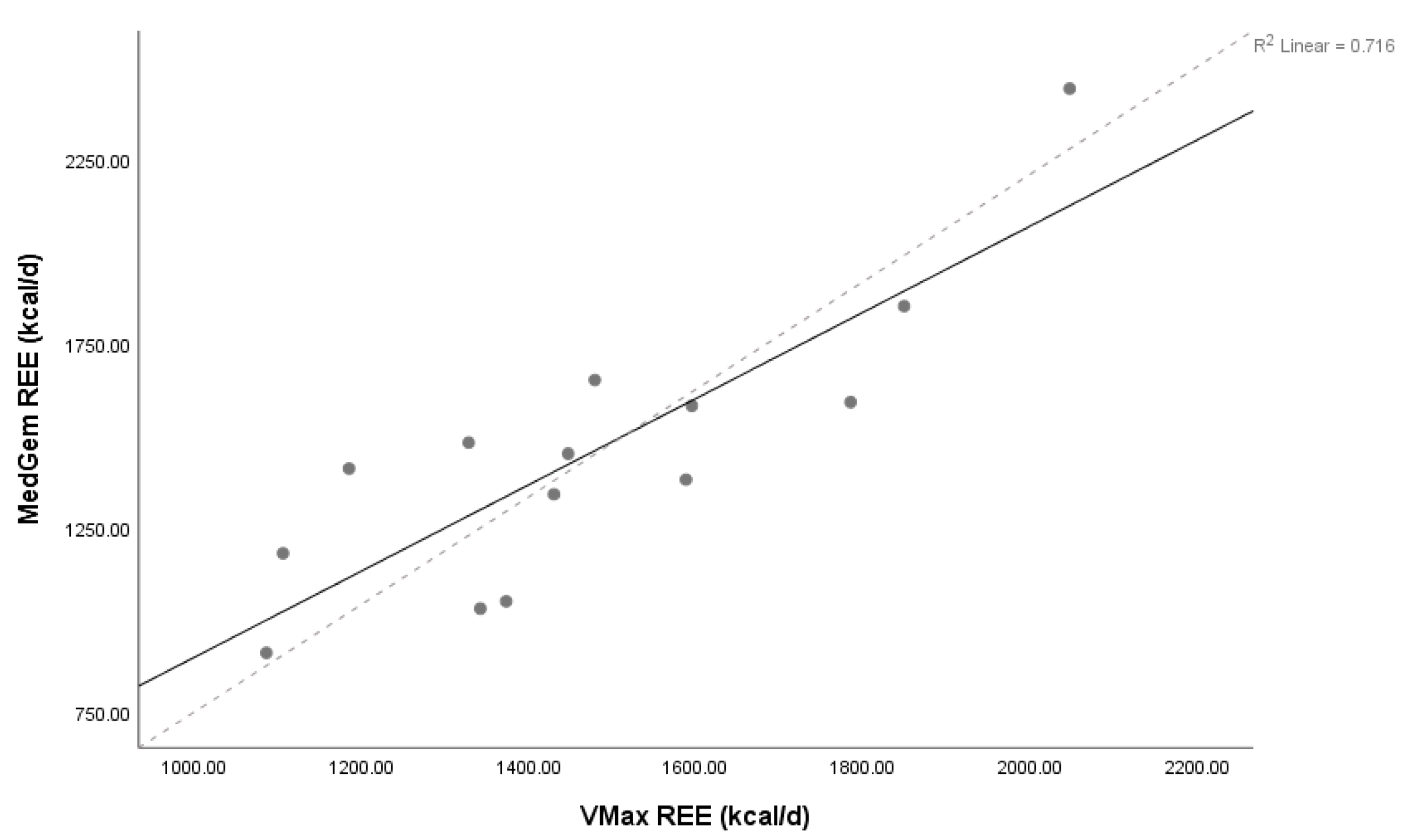
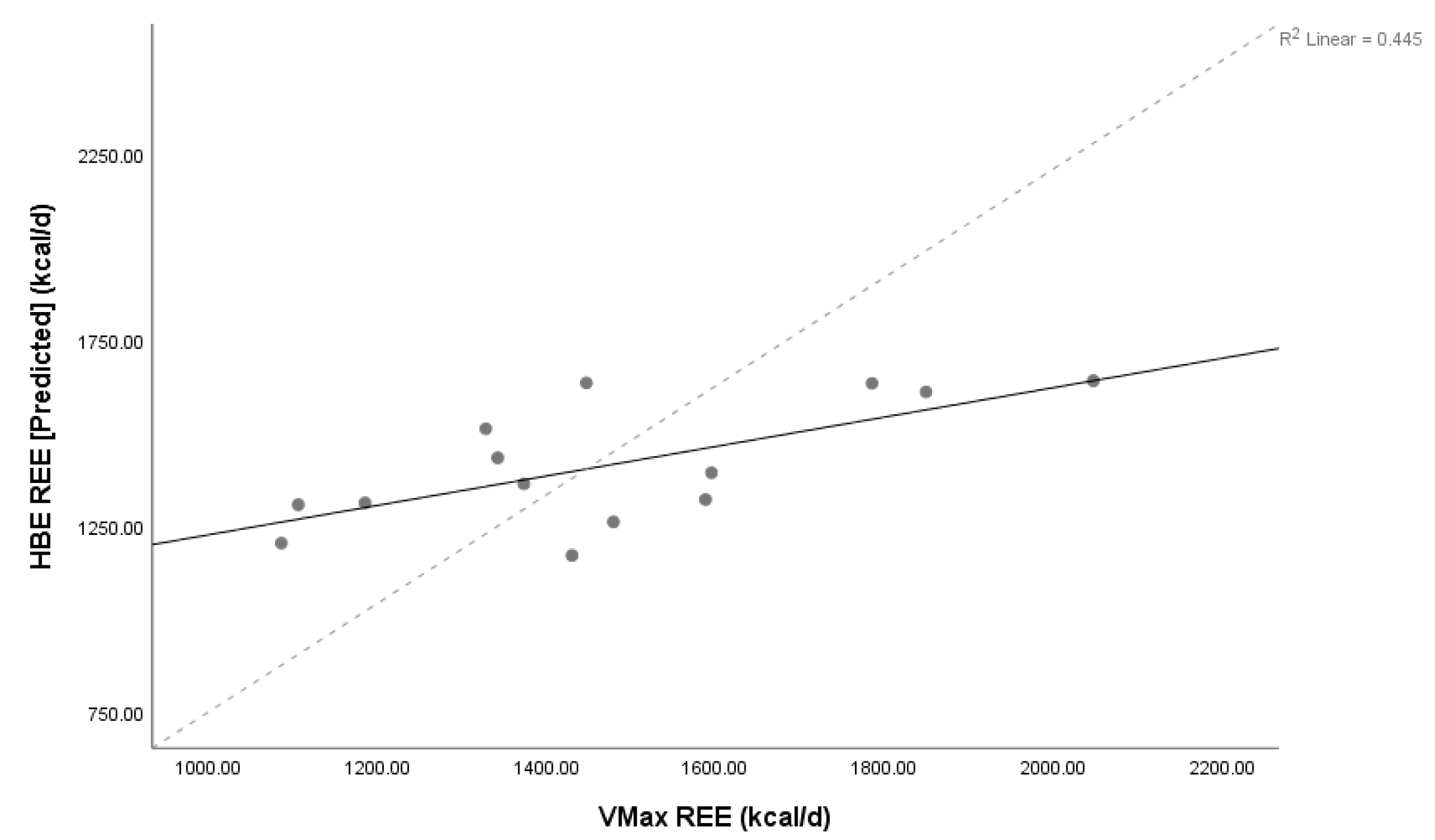
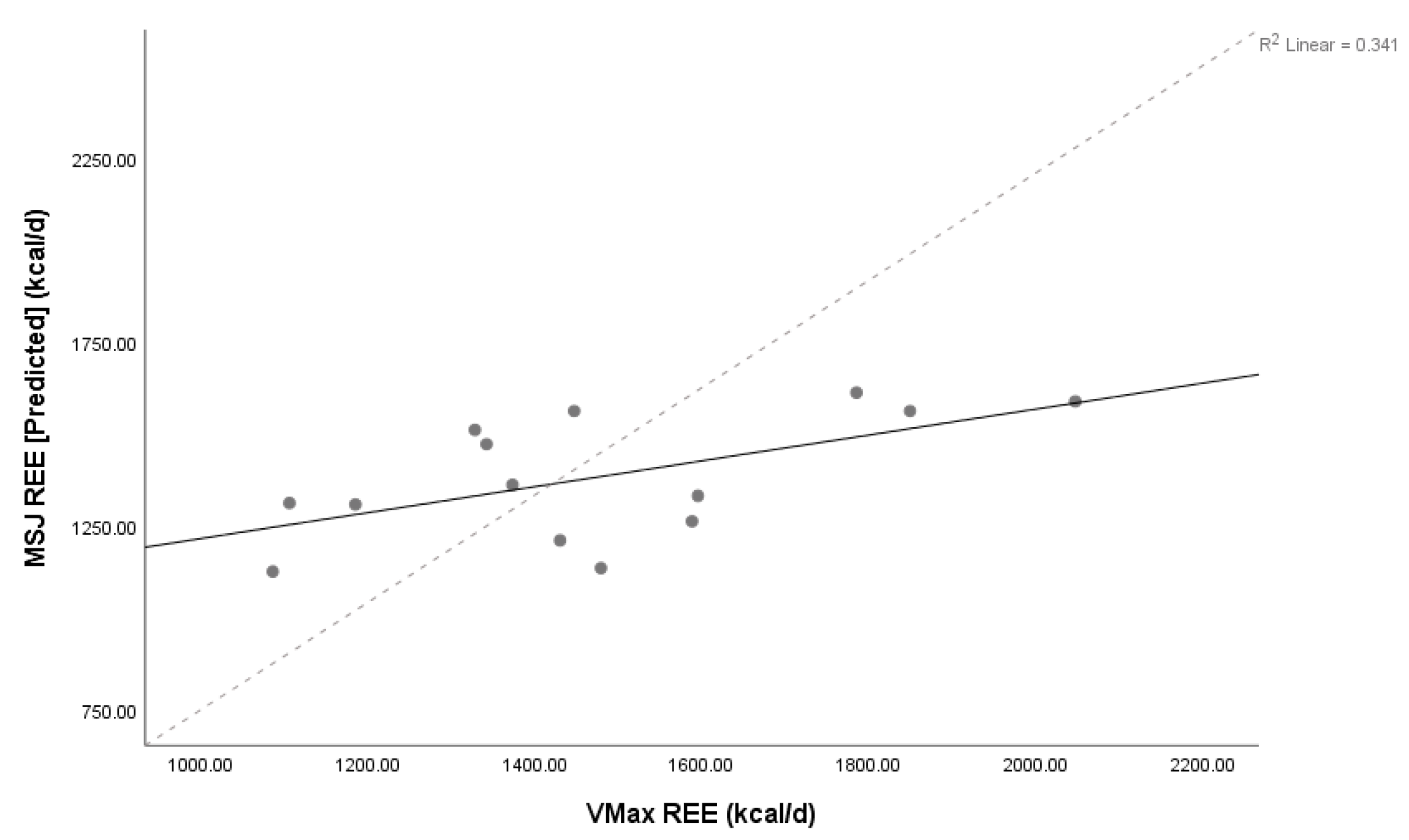
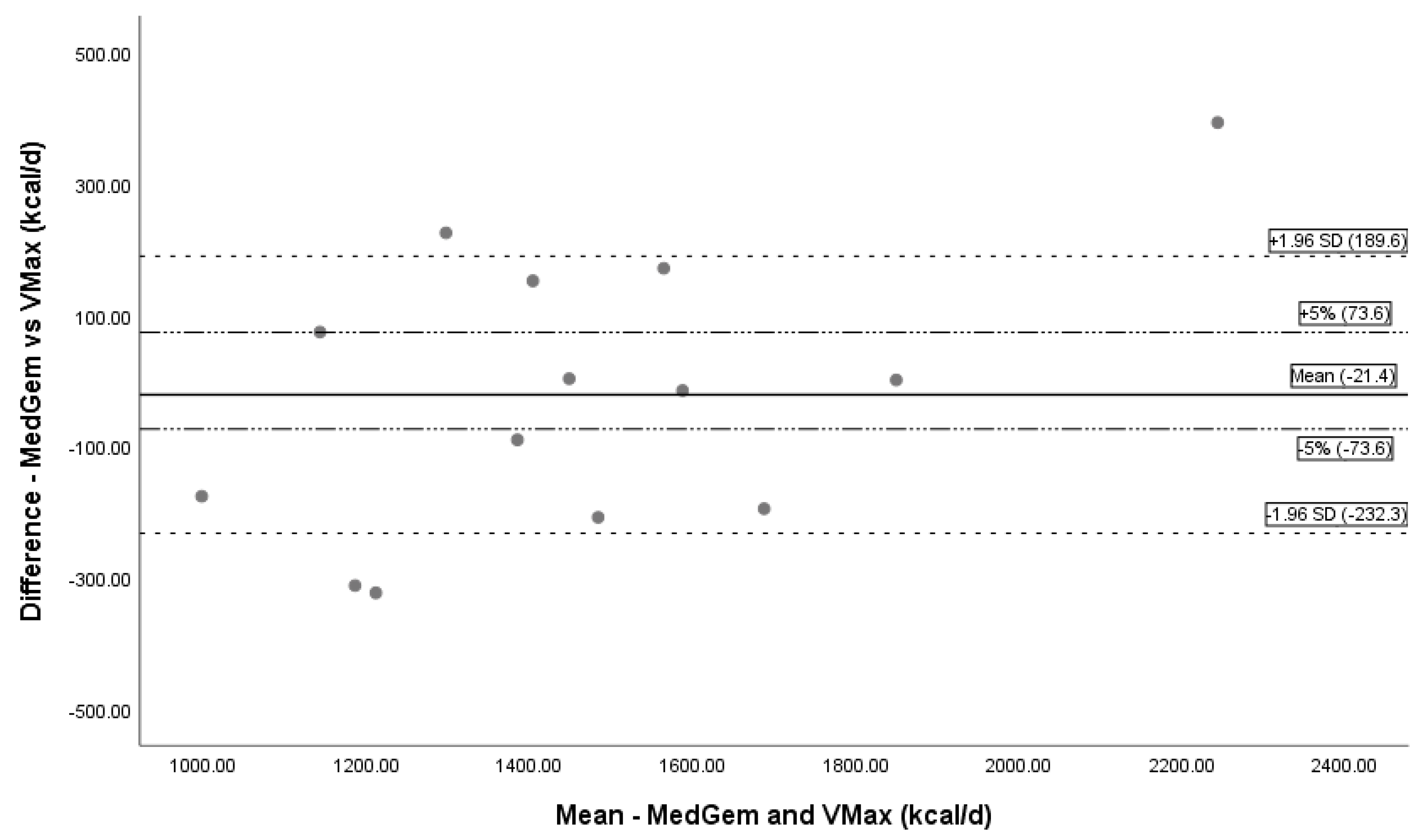
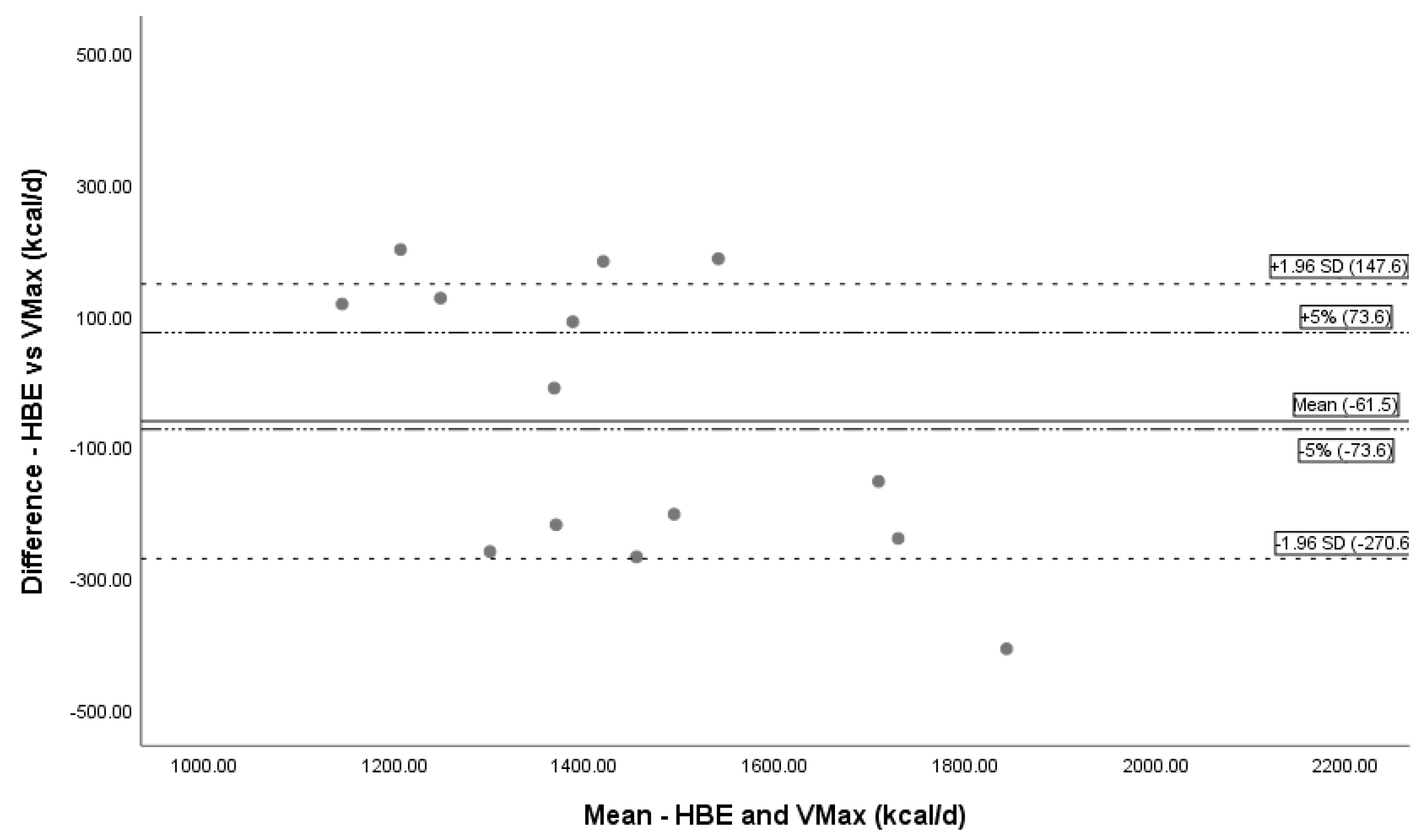
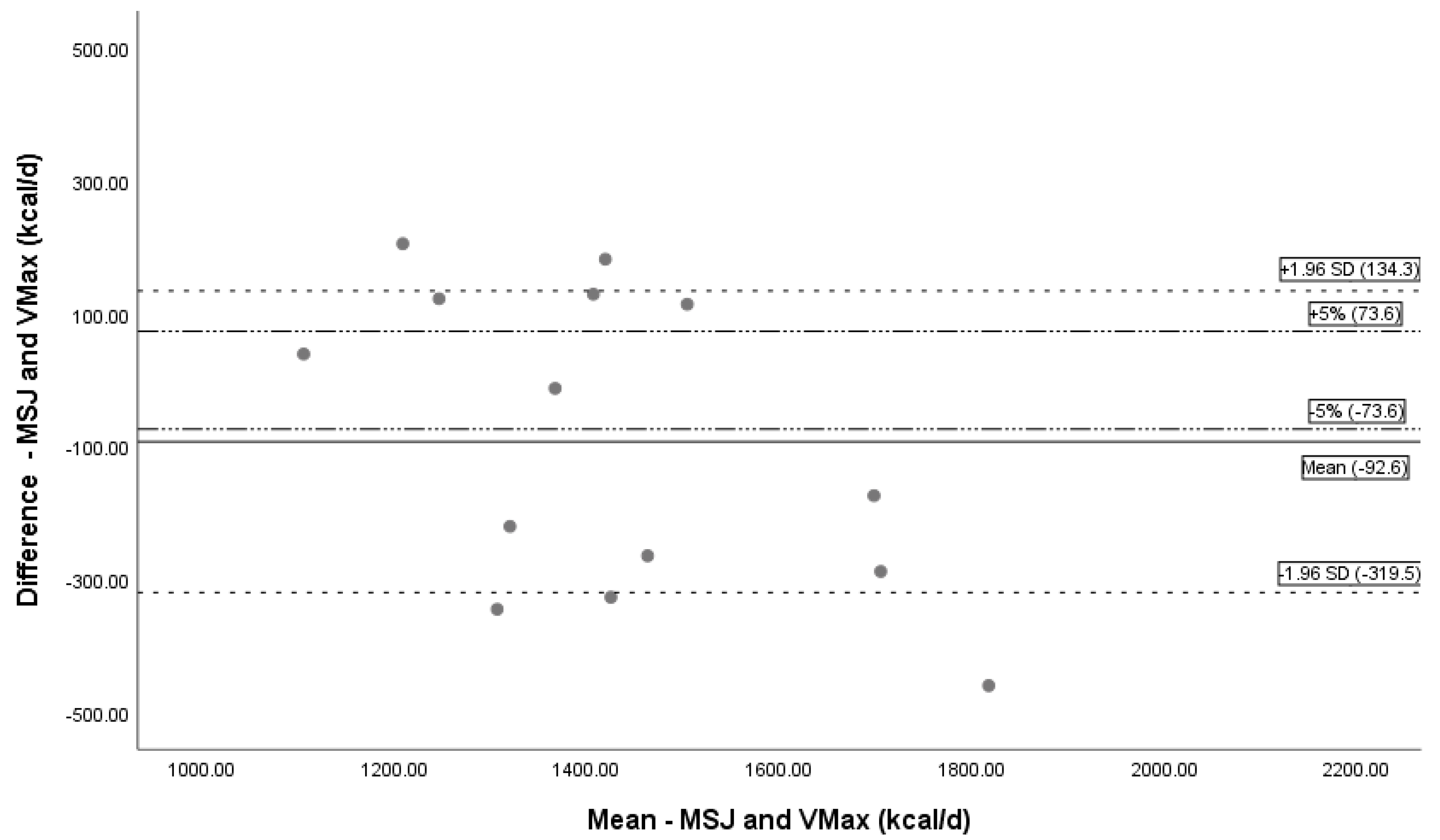
| Variable | Result |
|---|---|
| SGA Score | |
| A, mild (%) | 5 (36) |
| B, moderate (%) | 5 (36) |
| C, severe (%) | 4 (29) |
| Gender | |
| Male (%) | 10 (71) |
| Female (%) | 4 (29) |
| Age (years) | 53.5 ± 9.4 |
| Height (cm) | 167.7 ± 8.8 |
| Estimated dry weight (kg) | 65.1 ± 8.1 |
| Estimated dry BMI (kg/cm2) | |
| Males | 22.6 ± 2.8 |
| Females | 24.5 ± 2.4 |
| Aetiology of cirrhosis * | |
| Hepatitis C (%) | 5 (36) |
| Alcohol (%) | 3 (21) |
| Primary sclerosing cholangitis (%) | 3 (21) |
| Hepatocellular carcinoma (%) | 3 (21) |
| Non-alcoholic steatohepatitis (%) | 2 (14) |
| Hepatitis (%) | 1 (7) |
| Budd Chiari syndrome (%) | 1 (7) |
| MELD score | 12.3 ± 4.2 |
| Ascites/severity (n) | |
| None (%) | 9 (64) |
| Mild (%) | 1 (7) |
| Moderate (%) | 1 (7) |
| Severe (%) | 3 (21) |
| Method | REE (kcal/day) |
|---|---|
| Vmax | 1472.3 ± 279.3 |
| MedGem® | 1452.9 ± 386.0 |
| HBE (calculated) | 1412.8 ± 165.4 |
| MSJ (calculated) | 1381.7 ± 168.3 |
| Comparison Group | Mean kcal Difference (95% CI) | Lin’s Concordance Correlation Coefficient (ρC) (95% CI) | Mean Underpredicted kcal Differences (% difference) | Mean Overpredicted kcal Differences (% difference) |
|---|---|---|---|---|
| MedGem®–Vmax | −21.4 (−143.3–100.4) | 0.80 (0.55–0.92) | −188.4 ± 110.8 (n = 7) (13%) | 145.6 ± 138.2 (n = 7) (10%) |
| HBE–Vmax | −61.5 (−182.3–59.2) | 0.56 (0.19–0.79) | −220.3 ± 112.2 (n = 8) (18%) | 150.2 ± 44.9 (n = 6) (9%) |
| MSJ–Vmax | −92.6 (−223.6–38.4) | 0.47 (0.07–0.75) | −261.1 ± 132.3 (n = 5) (20%) | 132.1 ± 58.1 (n = 9) (8%) |
© 2019 by the authors. Licensee MDPI, Basel, Switzerland. This article is an open access article distributed under the terms and conditions of the Creative Commons Attribution (CC BY) license (http://creativecommons.org/licenses/by/4.0/).
Share and Cite
Schock, L.; Lam, L.; Tandon, P.; Taylor, L.; Raman, M. Indirect Calorimetry Performance Using a Handheld Device Compared to the Metabolic Cart in Outpatients with Cirrhosis. Nutrients 2019, 11, 1030. https://doi.org/10.3390/nu11051030
Schock L, Lam L, Tandon P, Taylor L, Raman M. Indirect Calorimetry Performance Using a Handheld Device Compared to the Metabolic Cart in Outpatients with Cirrhosis. Nutrients. 2019; 11(5):1030. https://doi.org/10.3390/nu11051030
Chicago/Turabian StyleSchock, Lauren, Louisa Lam, Puneeta Tandon, Lorian Taylor, and Maitreyi Raman. 2019. "Indirect Calorimetry Performance Using a Handheld Device Compared to the Metabolic Cart in Outpatients with Cirrhosis" Nutrients 11, no. 5: 1030. https://doi.org/10.3390/nu11051030
APA StyleSchock, L., Lam, L., Tandon, P., Taylor, L., & Raman, M. (2019). Indirect Calorimetry Performance Using a Handheld Device Compared to the Metabolic Cart in Outpatients with Cirrhosis. Nutrients, 11(5), 1030. https://doi.org/10.3390/nu11051030






